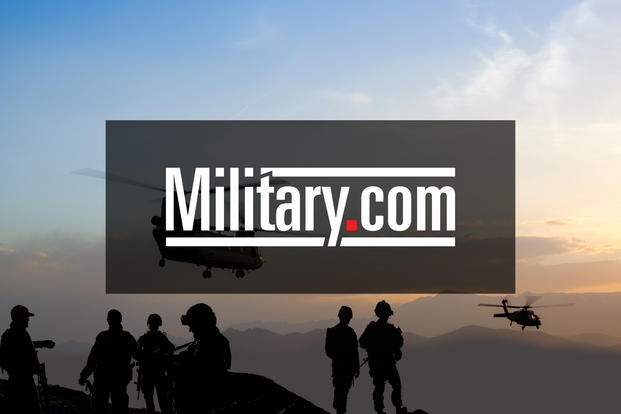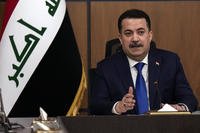-- Joseph V. Micallef is a best-selling military history and world affairs author, and keynote speaker. Follow him on Twitter @JosephVMicallef.
It was roughly a year ago that the Iraqi government of Prime Minister Haider al-Abadi announced the defeat of the Islamic State (IS) in Iraq by declaring that, "our heroic armed forces have now secured the entire length of the Iraq-Syria border." U.S. officials, while more circumspect, echoed similar sentiments. Former Secretary of Defense James Mattis, declared, "we sit here today at the end of 2017, the caliphate is on the run, we're breaking them."
A year later, despite continued progress in rolling back the last remnants of the territorial domain of Islamic State, the final defeat of IS seems less certain. Despite statements from the Trump White House that the Islamic State has been "obliterated," and is in in "its final throes," IS continues to show remarkable resiliency.
The organization's long reach was underscored recently by a suicide bombing outside of a shawarma restaurant popular with American troops in the town of Manbij; a region that had long been cleared of IS jihadists. The attack killed 16 people, four of whom were American military personnel. Moreover, over the months of November and December 2018, jihadists affiliated with IS, but operating independently of it, staged attacks in Egypt, Australia, the Philippines and Morocco. In addition, five people were left dead following an attack on a Christmas market in Strasbourg, France.
Closer to home, at the end of December, the FBI arrested a Georgia man, and self-declared IS supporter, Hasher Jallal Taheb, on suspicion of plotting to use an anti-tank missile to attack the White House. Taheb also considered attacks against the Statue of Liberty and other "targets of opportunity" in the DC area.
These attacks occurred within weeks of the Trump Administration's announcement that it was withdrawing the roughly 2,000 U.S. military personnel in Syria and that it would rely on Turkish military forces and their affiliated local militias to finish the final destruction of the remaining Islamic State militants in Syria.
The Deir ez-Zor Campaign 2017-2018
By the end of 2017, Islamic State forces in eastern Syria had been largely reduced to an 80-mile strip of the central Euphrates Valley running southeast from Deir ez-Zor to Al-Bukamal, just north of the Iraqi border. In addition, there was a smattering of small IS enclaves scattered throughout eastern Syria and portions of western Iraq.
The Deir ez-Zor campaign consisted of a series of engagements on both flanks of the mid-Euphrates Valley. On the eastern side, operations were conducted by the U.S. backed, Kurdish led, Syrian Democratic Forces (SDF). On the western side, operations were carried out by Syrian Armed Forces (SAF), accompanied by their Russian advisors and local militias.
The SDF campaign proceeded in fits and starts, and was paused on three separate occasions to deal with Turkish attacks against the Kurdish enclave of Afrin and in response to Turkish artillery attacks against Kurdish positions in northern Syria. The current phase of the campaign began on November 11, and is still in process.
The region hosts several major oil fields that were a lucrative source of income for Islamic State and have been tenaciously defended by IS militants.
By the end of 2018, Islamic State forces had been reduced to a small pocket, approximately 10 miles in length, from Wada Ajaj to Ash Shājilah. Originally it was believed that total IS strength in the Marashidah pocket was 2,000 to 3,000 militants. That number was subsequently increased to an estimate of 20,000 to 30,000.
The remaining leadership of Islamic State is probably holed up in this enclave. This includes IS leader Abu Bakr al-Baghdadi. The death of al-Baghdadi has been announced on numerous occasions by both Iraqi and Syrian forces, but never verified.
As of mid-January, SDF units were preparing for the final assault on IS's last remaining enclave.
According to the Trump Administration, Washington and Ankara had agreed that Turkey would take over the campaign against the Islamic State and the last of their militants from U.S. forces. It's not clear how this can be achieved from a practical standpoint. The bulk of the Turkish military forces and their supporting militias are in the north and west, whereas the remaining IS militants are in the southeast, literally the opposite side of Syria.
It's unlikely that either Syrian military forces or the SDF would allow Turkish troops transit through the territories they control. Turkish forces would need to oust SDF forces out of a sizeable chunk of the territory they hold before they would be able to engage with IS militants. Any such attempts to do so would precipitate intense fighting between the SDF and the Turkish military.
Beyond an expansion of air operations against IS, it is hard to see how Turkish forces would be in a position to roll up the last remaining pocket of IS territory.
In the meantime, IS has resorted to the same strategy it adopted in 2009. By 2011, when the Obama Administration pulled the bulk of U.S. troops out of Iraq, IS strength had been reduced to under 1,000 militants and three out of every four members of its leadership had been either killed or captured.
At that point, IS had lost virtually all of the territory it had previously controlled in the Sunni Triangle of western Iraq and had reverted back to an insurgency. Its primary strategy was a campaign of indiscriminate violence, combined with a program of kidnappings and assassinations against any leaders that emerged within the anti-IS, Sunni community.
As the U.S. and its SDF allies have rolled back Islamic State, it has fallen back on its previous strategy, targeted assassinations against Arab and Kurdish leaders in the newly liberated towns and villages, as well as a new terror campaign. In Iraq alone, there were over 1,600 acts of violence perpetrated by Islamic State during 2018.
In short, IS has a battle tested strategy of going underground during periods of weakness and waiting out U.S. resolve to maintain its troops in theater.
In 2011, IS had virtually ceased to exist. Within three years, it had seized control of half of Syria and a third of Iraq. That does not mean that a new U.S. withdrawal will result in a similar outcome, but neither should we assume that the destruction of Islamic State's territorial domain spells the end of the organization as a jihadist force.
Islamic State around the World
As of the end of 2018, Islamic State had approximately 50 affiliates around the world. Some affiliates existed in name only. Others, like the three in Libya, could only muster a few hundred committed jihadists. In many instances, the larger affiliates are either factions or splinter groups within existing jihadist organizations, like Boko Haram in Nigeria or al-Shabab in Somalia.
Western intelligence agencies estimate that Islamic State has an additional 30,000 to 40,000 active supporters around the world, with the bulk of those supporters, some 10,000 to 20,000, in north, west and east Africa, followed by another 5,000 to 10,000 militants and active sympathizers in Western Europe. The balance of its strength is in a broad arc from central Asia to southeast Asia and the Philippines.
In reality, these numbers probably grossly underestimate the potential strength of IS. Many militants opportunistically declare for one jihadist organization over another based on who can offer financial compensation at the time or the prospect of booty. These affiliations can be fluid and change quickly as conditions warrant.
Larger organizations, like Boko Haram or al-Shabab, often show different factions, each tied to one of the transnational jihadist movements. Sometimes these factions reflect ideological differences within the organizations, in most cases, however, they reflect more mundane personal rivalries between elites.
In Africa, for example, there are approximately 100,000 Islamic jihadists. Approximately one-third of these belong to the three largest jihadist organizations: Boko Haram/Islamic State West Africa Province (ISWAP), Islamic State in Sinai and al-Shabab.
Boko Haram, for example, currently operates as two separate organizations. One group, ISWAP is led by Abu Musab al-Barnawi, the son of the former founder of Boko Haram, Mohammad Yusuf. Its strength is estimated at around 3,500 jihadists. A second group, operating under the original name Boko Haram, is headed by Abubakar Shekau. That group is also an affiliate of IS, although Shekau was considered too extreme for local jihadists, hence his replacement by Barnawi.
The relationship between Boko Haram and Islamic State is indicative of the difficulties in estimated the strength of IS and its affiliates. According to U.S. intelligence sources, the combined strength of ISWAP and Boko Haram is around 5,000 militants. Nigerian sources, however, place Boko Haram's strength, including active sympathizers and former jihadists, at upwards of 50,000 militants.
Not all active sympathizers are committed jihadists. On the other hand, such sympathizers play an important support role within the organization. They are sources of funding and logistical support and some percentage may eventually become full-fledged militants.
The situation in West Africa is further complicated by the fact that the region has become the center of an extensive rivalry between Shiite and Sunni missionaries. Historically, the center of Shiite Islam was the countries surrounding the Persian Gulf. North and West Africa were overwhelming Sunni Muslim.
In recent years, the Shiite population of West Africa has been among the fastest growing in the Islamic world. Some of that growth is from Sunnis switching to Shi'ism, while another portion is coming from conversion of non-Muslims in the region.
The area has also become a critical conduit for shipments of drugs and arms between Hezbollah and its affiliates in South America, especially in Venezuela.
IS has another 1,500 or so fighters in the Islamic State in Sinai. There are approximately 5,000 jihadists, or jihadist sympathizers, operating in the Sinai. So, while around one-third of those militants are officially affiliated with IS, the potential pool that IS could eventually draw from is several times larger.
In Libya, Islamic State is officially down to around 500 militants. This is substantially less than the several thousand militants it was believed it could muster several years ago. Currently, IS no longer controls any significant towns or cities in Libya, but continues to operate an insurgency, striking at targets of opportunity against both competing Libyan governments.
The Islamic State in Greater Sahara is the remnant of the al-Qaeda affiliated group in Mali. In addition, there are affiliates in Tunisia, Morocco, Egypt and Algeria--the latter is the IS splinter of al-Qaeda in the Islamic Maghreb (AQIM).
The Islamic State in Somalia has waxed and waned over the last several years. It consists of a faction within the al-Shabab organization that on occasion have affiliated themselves with Islamic State. Al-Shabab has been at the center of an intense rivalry between IS and al-Qaeda. Currently, the official strength of IS in Somalia is only a few hundred militants, but al-Shabab has a pool of tens of thousands of militants that it can draw from and which could be made available to IS.
Finally, IS has a small, but active presence in Kenya, Tanzania and Uganda. In addition, there have been persistent reports of IS cells in South Africa and elsewhere in the region among the Muslim migrant worker communities from East Africa.
In Europe, Islamic State continues to rely on a pool of between 5,000 and 10,000 veterans of the Syrian and Iraqi civil wars who have returned home and remain ideologically committed to IS. In addition, there is a large number of sympathizers who form a significant pool of potential self-radicalizers. These self-radicalizers operate independently of IS, receive no financial support, training or instructions, and typically only declare their support for IS immediately before an act of violence.
This group adds to the continuing pattern of low-level random violence, which currently plagues Western Europe.
In Asia, IS has a significant presence in Afghanistan, and to a lesser extent in Pakistan, and on the southern Philippine island of Mindanao. It is not clear that IS has had much success in expanding its Afghan and Pakistani footprint over the last year. It did attempt to make some inroads into the Afghan drug trade, presently controlled by the Taliban, without much success. At this point it still lacks the logistical ability to move narcotics out of central Asia in a consistent manner.
Where IS has been successful, is in establishing a low-level presence across much of southeast Asia. These beachheads include all of the principal Islamic regions of southeast Asia: southern Thailand, Malaysia, Indonesia and even Singapore.
Islamic State 2019: An Assessment
2019 will mark the year where the final vestiges of Islamic State territory will be rolled up. Given the expected strength of IS militants in the al-Marashidah pocket, however, it is likely that this will be a protracted campaign that will last several months. The question is, will the remaining leadership of IS, and in particular al-Baghdadi, be captured or killed and what will happen to the balance of the remaining militants?
Ideally, the final campaign will require the support of Iraqi and Syrian armed forces to ensure that the surrounding region can be sealed and to ensure the capture of escaping IS militants, especially any of its leadership.
Additionally, it's estimated that IS has amassed a war chest of around $400 million, mostly in the form of cash and gold. Some portion of this wealth is probably safely hidden, but it's likely a significant chunk is with the IS leadership in the Marashidah pocket.
Africa will continue to be the main focus of Islamic State over 2019, and beyond. The region offers some significant advantages to IS. It has a large population of experienced jihadists and jihadist sympathizers from which it can recruit. In many parts of the region, national governments' intelligence and security reach is limited. There are large rural areas that lack any kind of a government presence.
Moreover, the region sits in the middle of drug, arms and illegal migrant smuggler routes, which represent a lucrative source of income for jihadist organizations.
The breakdown of national governmental authority in many countries of this region, combined with the growing intense rivalry between Sunni and Shiite missionaries, is radicalizing elements of the local Muslim population to the benefit of organizations like Islamic state.
Moreover, in an environment where governmental authority is often weak to nonexistent, Islamic State's strategy of creating chaos and instability plays to its historic tactics.
IS will continue to be an opportunist organization, looking to establish itself where the opportunity affords itself and shaping its strategy based on the presence and strength of its opponents. While it will continue to look for opportunities to expand around the globe, it is in north, east and especially West Africa, that Islamic State 3.0 is likely to appear.
-- The opinions expressed in this op-ed are those of the author and do not necessarily reflect the views of Military.com. If you would like to submit your own commentary, please send your article to opinions@military.com for consideration.















